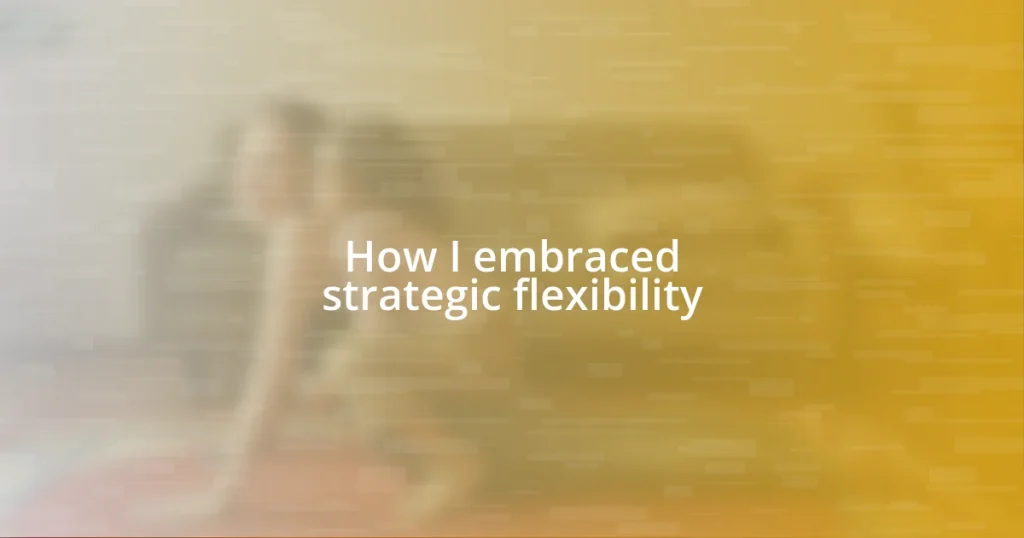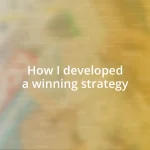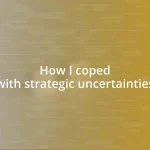Key takeaways:
- Strategic flexibility involves adapting to change while maintaining long-term goals, emphasizing the importance of openness to feedback and collaboration.
- Key principles like continual learning, proactive risk management, and embracing change can transform challenges into growth opportunities.
- Real-world examples demonstrate that flexibility fosters creativity and resilience, ultimately leading to unexpected benefits and improved outcomes.

Understanding strategic flexibility
Strategic flexibility, at its core, is about adapting to change while keeping long-term goals in sight. I vividly recall a moment in my career when a promised partnership fell through just days before a crucial product launch. It was nerve-wracking, but I realized that with the right approach, I could pivot and explore alternative partnerships. Reflecting on that experience, I find myself asking: how often do we cling to our original plans even when the landscape shifts?
The ability to pivot effectively relies on a blend of foresight and responsiveness. I remember sitting down with my team one evening, brainstorming ways to leverage emerging market trends that we hadn’t initially considered. It was exhilarating to see everyone’s ideas flow, revealing new opportunities. Engaging with varying perspectives not only enriches decision-making but also fosters a culture where flexibility is valued and encouraged. Isn’t it fascinating how a single setback can unveil a myriad of possibilities?
In essence, understanding strategic flexibility involves recognizing that change is not merely an obstacle but an opportunity in disguise. I’ve learned that openness to feedback and a willingness to adapt can turn challenging situations into stepping stones toward success. This mindset shift makes all the difference, transforming anxiety around uncertainty into excitement for the future. How can we cultivate such a mindset in our daily practices?

Importance of strategic adaptability
Adaptability is crucial in today’s fast-paced environment. I remember the time when our company faced unexpected regulatory changes; we had to rapidly reassess our strategies. It was stressful, yet it highlighted how crucial it is to stay flexible. I felt a surge of urgency, knowing that our success depended on how quickly we could adjust our plans and resources to align with regulations while still driving toward our objectives.
Having strategic adaptability not only safeguards against risk but also opens doors to new opportunities. For instance, my team once had to pivot from a traditional marketing approach to a digital-first strategy almost overnight. The excitement in the air was palpable; everyone embraced the change and unleashed their creativity. This experience reiterated to me that adaptability is not about abandoning our goals; instead, it’s about enhancing them by welcoming new paths. Don’t you often find that when you adapt, you uncover unexpected avenues of growth?
By maintaining a mindset geared toward adaptability, leaders can better navigate tumultuous waters. I’ve witnessed teams flourish when they embrace change and seek innovative solutions. When faced with uncertainty, we should remember there’s power in our ability to adjust and thrive. The journey can be daunting, but those who adapt often find themselves one step ahead in the game. Have you considered how your own flexibility can turn challenges into advantages?
| Importance of Strategic Adaptability | Traditional Approach |
|---|---|
| Embracing Change | Sticking to the Plan |
| Promotes Opportunity Discovery | Limits Innovation |
| Enhances Team Collaboration | Encourages Isolation |
| Boosts Agility | Leads to Rigidity |

Key principles of strategic flexibility
Understanding the key principles of strategic flexibility has been transformative for me in both my career and personal growth. One principle I hold dear is continual learning. I distinctly recall a time when I took part in a workshop about agile methodologies. It dramatically changed my perception of project management. Instead of rigid timelines, I began to appreciate the importance of iterating and evolving based on team input and market demands. This approach not only encourages quick adjustments but also empowers everyone to contribute, leading to more innovative outcomes.
Another critical principle is proactive risk management. I learned this firsthand during a particularly challenging project when a key supplier unexpectedly went out of business. Instead of panicking, my team and I quickly assessed alternative suppliers while simultaneously brainstorming cost-effective solutions. By staying ahead of potential setbacks, we not only mitigated disruption but also discovered a new supplier who ultimately provided better service. Here are some principles I consider essential:
- Continual Learning: Embrace new knowledge and adapt your strategies accordingly.
- Proactive Risk Management: Anticipate potential setbacks and have contingency plans in place.
- Collaboration and Open Communication: Foster an environment where team members freely share ideas and concerns.
- Embracing Change: Approach changes as opportunities for growth rather than obstacles.
- Long-term Vision with Flexibility: Keep your goals in sight while being open to altering the path to reach them.
These principles can truly reshape how we view strategic challenges, and I’ve found that, with the right mindset, every obstacle can lead to a path less traveled but full of promise.

Steps to implement strategic flexibility
To implement strategic flexibility, I’ve found that the first step is to cultivate an adaptable mindset within your team. I remember leading a brainstorming session where we redefined our project goals based on recent market insights. By encouraging everyone to share their thoughts, we not only generated fresh ideas but also fostered a sense of ownership and collaboration. Wouldn’t you agree that when team members feel valued, they are more likely to contribute to innovative solutions?
Next, establishing a clear framework for continual feedback can drive your adaptability efforts. I once initiated weekly check-ins, where we assessed our progress and made real-time adjustments. This practice highlighted areas for improvement and empowered our team to seize emerging opportunities. It reminded me that flexibility requires a reliable mechanism for reflection and evolution. Have you noticed how consistent communication can transform a project’s trajectory?
Lastly, it’s essential to embrace calculated risk-taking as a way to implement strategic flexibility. There was a time when I advocated for a bold marketing experiment that seemed daunting. Although initial results weren’t as expected, the insights we gained were invaluable. Taking risks not only enhanced our strategic flexibility but also taught us resilience. How often do you think we hold back from trying something new out of fear of failure? Embracing the unknown can truly open doors we never imagined.

Overcoming challenges in strategic flexibility
Overcoming challenges in strategic flexibility often requires a shift in mindset. I remember a period when a significant project was derailed due to unforeseen market changes. Initially, there was frustration and a sense of defeat among the team. But I realized that instead of dwelling on what went wrong, we could pivot and explore new avenues. This transformation wasn’t instantaneous; it involved patience and open dialogue. Have you ever found yourself in a similar situation, where overcoming a setback revealed unexpected opportunities?
One of the toughest hurdles I faced in embracing strategic flexibility was getting my team on board with change. There was resistance, as many felt comfortable with the status quo. I decided to share my own initial hesitations about abandoning familiar routines. By being transparent about my fears, I created a space for others to voice their concerns. It struck me that vulnerability can build trust and facilitate change. How often do we overlook the power of shared experiences in forging a path through uncertainty?
Another challenge can be the balance between rapid adaptation and maintaining focus on long-term goals. I’ve experienced this firsthand while juggling multiple projects. At times, the need to respond to immediate demands felt overwhelming, blurring our vision for the future. In one instance, we nearly abandoned a promising initiative for a quick win. It took a heartfelt conversation with my team to refocus our priorities and remind everyone of our larger mission. Isn’t it fascinating how recalibrating our focus can ignite renewed passion and commitment?

Measuring the impact of flexibility
Measuring the impact of flexibility begins with evaluating both quantitative and qualitative results. I remember an instance where we adjusted a project mid-course based on client feedback. Later, analyzing the performance metrics not only showed an increase in customer satisfaction but also a significant boost in our team’s morale. Wouldn’t you agree that seeing real-time results can energize a team’s commitment?
On a more personal note, I often use feedback loops to gauge how flexible strategies enhance overall productivity. During one such review, I discovered that team members felt empowered to suggest changes, leading to a noticeable improvement in our workflow. It’s remarkable how involving the team in measuring impact cultivates a sense of ownership that fuels further adaptability. Have you ever noticed how empowered teams tend to exceed expectations?
Finally, beyond numbers, I find it essential to cultivate stories of resilience that arise from embracing flexibility. I recall a team member who shared how their innovative approach to a problem made a substantial difference in our project’s success. These stories resonate deeply and provide a rich context for assessing flexibility’s influence. How do you capture and reflect on the narratives that emerge from your flexibility initiatives? In my experience, these personal accounts often yield the most profound insights.

Real world examples of flexibility
I remember a time when a major product launch was on the verge of collapse due to a sudden shift in consumer preferences. Instead of proceeding with the original plan, my team and I brainstormed new ideas, allowing room for creative solutions to shine. This experience taught me that flexibility isn’t just about changing course; it’s about harnessing the collective ingenuity of a team during uncertainty. Have you experienced a moment where an unexpected challenge led to a better outcome?
A striking example of flexibility came when a key supplier faced logistical issues, threatening our project timelines. We quickly sought alternatives rather than panicking, reaching out to smaller vendors and establishing new partnerships. This adaptability not only saved our project but also opened doors to fresh collaborations. It made me wonder—what new connections can we foster when we embrace change instead of resisting it?
I also think about the time when we implemented a remote work policy, shifting from a traditional office setup. Adapting to this new normal required us to be flexible in our communication strategies and workflows. Initially, there were bumps along the way, but as we settled in, I saw increased productivity and creativity among team members. It reminded me that flexibility often leads to unexpected benefits—what innovative practices have you found through embracing change?















